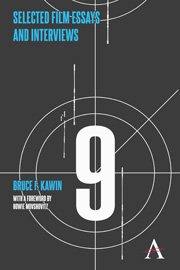Book contents
- Frontmatter
- Contents
- Foreword
- Preface
- PART I VIOLENCE AND POLITICS
- PART II HORROR AND SCIENCE FICTION
- PART III REVIEWS
- PART IV INTERVIEWS
- PART V LITERATURE AND NARRATION
- PART VI GETTING IT RIGHT
- 18 Creative Remembering and Other Perils of Film Study
- 19 Late Show on the Telescreen: Film Studies and the Bottom Line
- 20 Video Frame Enlargements
- 21 Three Endings
- Acknowledgments
- Index of Names and Titles
21 - Three Endings
from PART VI - GETTING IT RIGHT
Published online by Cambridge University Press: 05 May 2013
- Frontmatter
- Contents
- Foreword
- Preface
- PART I VIOLENCE AND POLITICS
- PART II HORROR AND SCIENCE FICTION
- PART III REVIEWS
- PART IV INTERVIEWS
- PART V LITERATURE AND NARRATION
- PART VI GETTING IT RIGHT
- 18 Creative Remembering and Other Perils of Film Study
- 19 Late Show on the Telescreen: Film Studies and the Bottom Line
- 20 Video Frame Enlargements
- 21 Three Endings
- Acknowledgments
- Index of Names and Titles
Summary
In this article, published in 2011 by Film Quarterly, a shot near the end of Avatar is compared with a shot near the end of La Roue, leading to observations about the contemporary viewer's willing suspension of disbelief and the changing nature of the indexical sign in cinema. (As an indexical sign, a photograph can be grounded in the reality outside the camera by the light that radiates from or bounces off whatever is being photographed and physically affects the emulsion, as Bazin argued without getting into semiotics.) Historically and technologically, this was written in the digital era, which followed the video era, which followed the film era.
When he saw the clouds moving around the mountain like a wheel and had the cameraman take several shots of them, Abel Gance must have been ecstatic. He may have been waiting for the shot for months, or it may have been a matter of good fortune that he was presented with a real-world image that related to the symbolic core of his La Roue (The Wheel, 1922) and was fit to be part of the summing up of the whole long movie: a natural image of the wheel, defined at the end (quoting the intertitles) as an “eternal tragic dance” in which “everything turned…even the clouds, ” and shown in an icon in the corner of many of the intertitles as a torture wheel on which a prisoner's body is broken.
- Type
- Chapter
- Information
- Selected Film Essays and Interviews , pp. 196 - 202Publisher: Anthem PressPrint publication year: 2013



